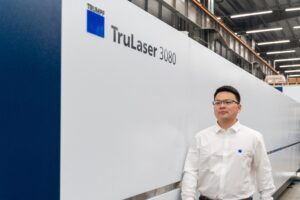TRUMPF cuts XXL sheets with less waste
New TruLaser 3080 fiber laser-cutting machine fabricates up to eight meter long parts// Machine can run in multi-shift operation without automation // New “nano joint” technology boosts process reliability and reduces material wastage

High-tech company TRUMPF will be showcasing a new laser-cutting machine that specializes in oversized sheets at its INTECH in-house trade show, which will be held from May 17 to 20, 2022. The TruLaser 3080 fiber fabricates parts in sheets up to eight meters long and is particularly adept at cutting large and heavy parts weighing up to 7,850 kilograms, such as facade components and trailers for trucks or cranes. The TruLaser 3080 fiber can also be used for small and medium-sized parts, so operators can easily use it to its full capacity and make optimal use of their production capacity. “There are only a few companies in the sheet-metal fabrication market that can cut oversized parts precisely to size. We pride ourselves on being a solution provider, and this machine really does give our customers a competitive edge and the ability to process even more jobs in less time,” says TRUMPF product manager Patrick Schüle. The machine can handle sheet thicknesses up to 50 millimeters and processes a variety of materials ranging from aluminum to mi
Multi-shift operation without automation

The TruLaser 3080 can be used in multi-shift operation without requiring complex automation. It comes with an automatic pallet changer that automatically inserts a second sheet as soon as the laser has completed its first cutting pass. This results in an overall machining area of 40m2 of sheet metal and allows the machine to cut parts for several hours without the operator having to add any additional raw material.
Less material, more productivity
Due to the size of the panel, different component shapes can be nested in the cutting program in a material-saving manner. This allows users to use almost the entire raw material. The machine is also equipped with a universal cutting unit with a fully adaptive lens system. The focus diameter of the laser beam can be selected as desired. With this flexibility, the TruLaser 3080 fiber effortlessly manufactures a wide variety of applications. In addition, it achieves very high productivity and quality in all sheet metal ceilings.
Maximum flexibility
The machine can process a wide range of materials including mild steel, stainless steel, copper and brass, and it can even create high-quality parts from thin metal sheets. From the smallest part to the largest, the TruLaser 3080 comfortably tackles every job and gives fabricators the flexibility they need to broaden their offerings and cater to a wide range of applications. In addition to an oversized sheet, companies can also place several smaller sheets on the pallet in the machine. This gives them even more flexibility in production.
Nano joints: reliable tabbing without wasting material
The TruLaser 3080 also features TRUMPF’s new “nano joints” technology, which boosts process reliability on the shop floor by eliminating the need for through-thickness tabs, or “micro joints”, in sheet-metal fabrication. Micro joints are commonly used to ensure that cut parts do not bank out while the rest of the sheet is being cut. They remain in place until they are broken by a production worker after the parts have been removed from the machine. Subsequently, the breakage points on the cut edge need to be smoothed, which leads to additional finishing work. Micro joints also increase the time it takes to remove parts from the nest, because it is not always possible to break the joints smoothly. As well as adding time to the overall process, micro joints also waste material because operators cannot place parts directly next to each other in the nest.
Unlike micro joints, TRUMPF nano joints only create tiny retaining tabs. This enables users to arrange parts directly adjacent to each other in the sheet, thereby saving material. In addition, the processing time is shortened because the laser creates the retaining tabs while cutting the contour of the component. Almost no post-processing work is required because the contour injury is barely visible. Production workers do not have to apply as much force to separate parts from the metal sheet, so they can remove parts from the nest quicker.
This content was first posted on the Trumpf website.

